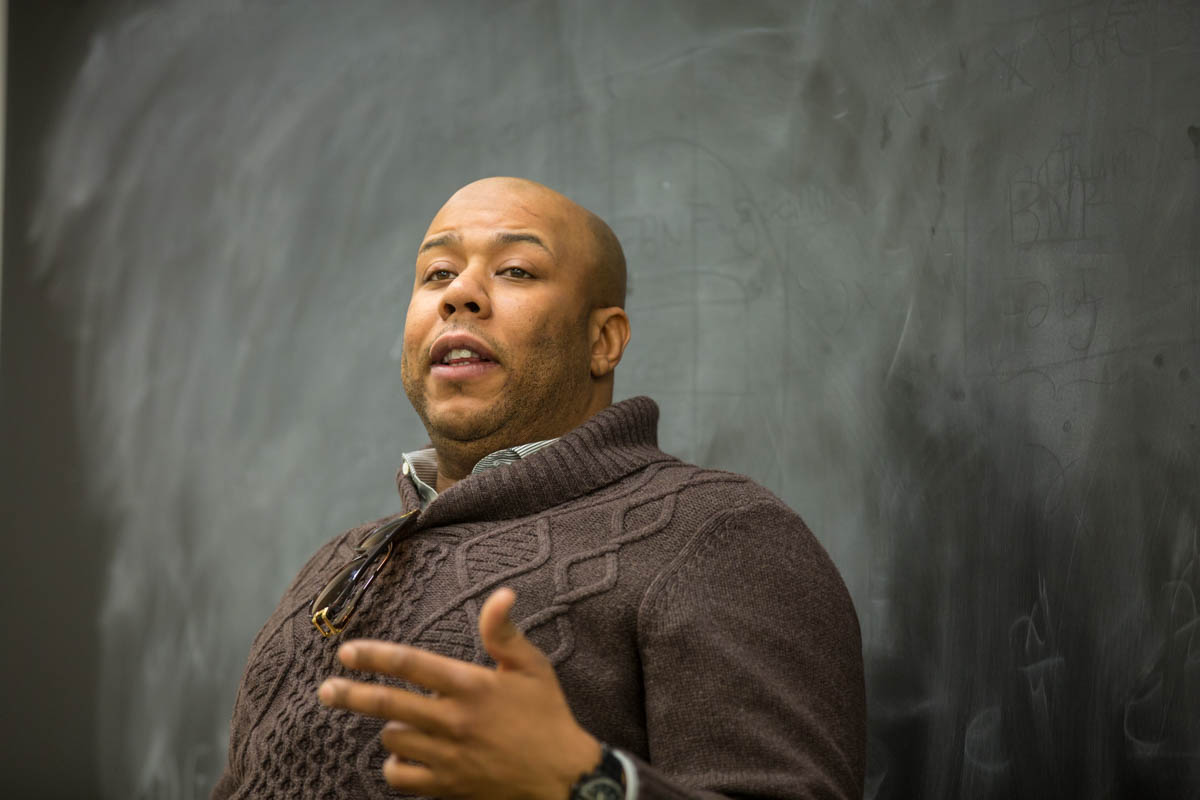‘A real depiction of what thug life really is’

Karl "Dice Raw" Jenkins discussed his album, which addresses the issue of mass incarceration in America.
Not many hip hop artists make records inspired by books. Hip-hop artist Karl “Dice Raw” Jenkins is quick to point out, though, that he’s not the first. The Roots, a group with whom he has frequently collaborated, recorded Things Fall Apart, an album inspired by Chinua Achebe’s novel of the same name.
Inspired himself by Michelle Alexander’s The New Jim Crow: Mass Incarceration in the Age of Colorblindness, Raw released his concept album, Jimmy’s Back, in December 2013.
Raw, a Philadelphia native, discussed his album and screened its accompanying documentary Wednesday at STEPS, just prior to Alexander’s keynote address for Lehigh’s MLK Celebration.
James Peterson, associate professor of English and director of Africana Studies, introduced Raw and described his reaction to learning about Jimmy’s Back.
“We are so effective at critiquing hip hop culture—it’s materialistic, it’s misogynistic, it’s bad for kids—that I didn’t really believe it when I first heard it. He made an album that’s inspired by Michelle Alexander’s The New Jim Crow? That was a fascinating thing to me,” said Peterson.
Several years ago, a friend gave Raw a copy of Alexander’s book and insisted that he read it. Raw eventually purchased the audio version and listened to it on a train from Philadelphia to New York.
“It was really eye-opening for me,” said Raw. “My mouth was probably on the floor for the whole train ride.”
“I know people who’ve been locked up since they were 13 years old and they’re still in jail. [They] go in as a juvenile and you never see this person again till they’re 23. And then a month or two go by and they’re back in till they’re 34. Even that—knowing somebody who’s spent that much time in jail—it still hadn’t dawned on me how systematic it was until I read Michelle’s book. The way she broke it down, it was real insightful. It made me want to do my part, which is why I did the album.”
Raw discussed the evolution of hip hop over time and its role in black culture today.
“When I was growing up, hip hop was a socially political art form that kind of spoke about what was going on in the inner city, the world,” said Raw. “The rap that comes out now is just so different from that. I feel like it’s almost like a soundtrack to promote a fake criminal lifestyle that doesn’t even exist in a real criminal’s lifestyle... to me that doesn’t really make a lot of sense.”
For that reason, Raw decided to use amateur rappers who have spent time in prison on Jimmy’s Back.
“I wanted to give a real depiction of what thug life really is from a thug’s perspective. Me, personally, I couldn’t really do that because I’m not a thug,” said Raw. “When they talk about what’s going on in the jail, they talk about the hole, they talk about getting beat up, they talk about no unity, the talk about how the cases were uneven, the [racially discriminatory] jury. That’s the kind of narrative I wanted to expose with Jimmy’s Back versus the criminal super-rapper that doesn’t really exist anyway.”
The “criminal super-rapper” has become the norm in hip hop, Raw said, because many rappers fear the loss of influence that might accompany a move away from a criminal image. Raw cited drug references in hip-hop artist Sean “P. Diddy” Combs’ lyrics and then noted a contradiction in Combs’ tough-guy image: his fashion label, Sean John, is sold at department stores.
“Diddy, what are you talking about? I just came from Macy’s and you’re selling suits. I don’t think there’s anything wrong with selling suits and I don’t think he does either, but I think he feels like if he is promoting that more so than his street-credibility image that he may lose the influence that he has. I have to ask myself why.”
Raw explained that hip hop began during a time when the American economy was struggling. The music had more of a political voice then. Later, when rappers started making large sums of money, the message changed.
“When the money kept growing, gangsta rap was just selling. The deaths of [rappers] Biggie Smalls and Tupac [Shakur] legitimized it. When they died, that kind of solidified the gansta narrative.”
Raw would like to see the conversation change. Jimmy’s Back is a start, and not just in hip hop.
“I knew… even before I heard the album, that I was going to be using this album in the classroom, that I would be talking to people about this record because believe it or not, as popular as Michelle Alexander’s The New Jim Crow is, I would bet you dollars to donuts that this record is going to circulate more amongst the people who need to understand those systematic structures,” said Peterson.
“I’m not knocking scholars. I’m a scholar myself. But a lot more people are going to listen to this man’s album than will buy my book. That’s the environment that we live in. The reality is if you’re trying to reach young people and you want them to understand the systematic structures that are at play in terms of mass incarceration, you’ve got to hit them from multiple angles.”
Story by Kelly Hochbein
Photos by Christa Neu
Posted on:



